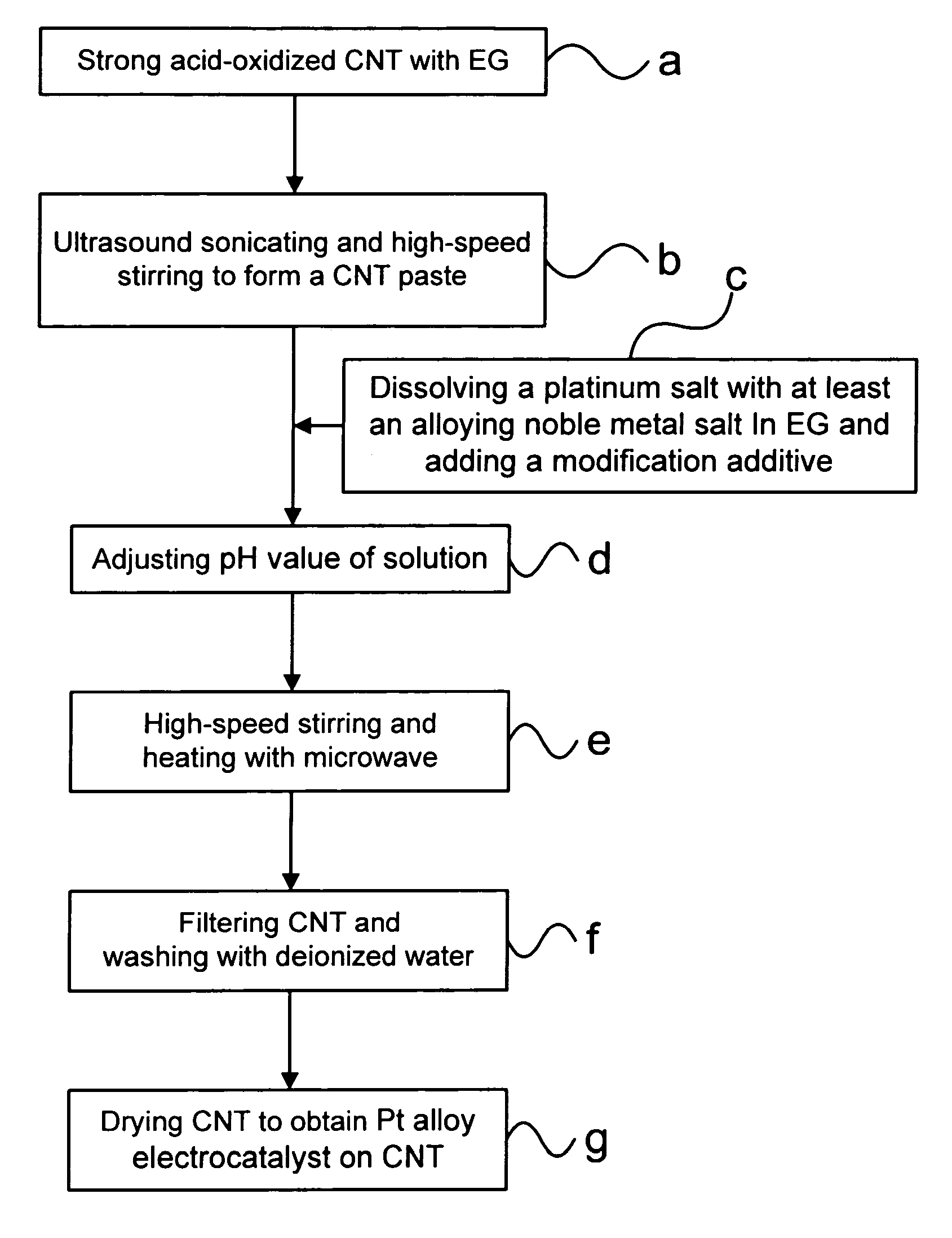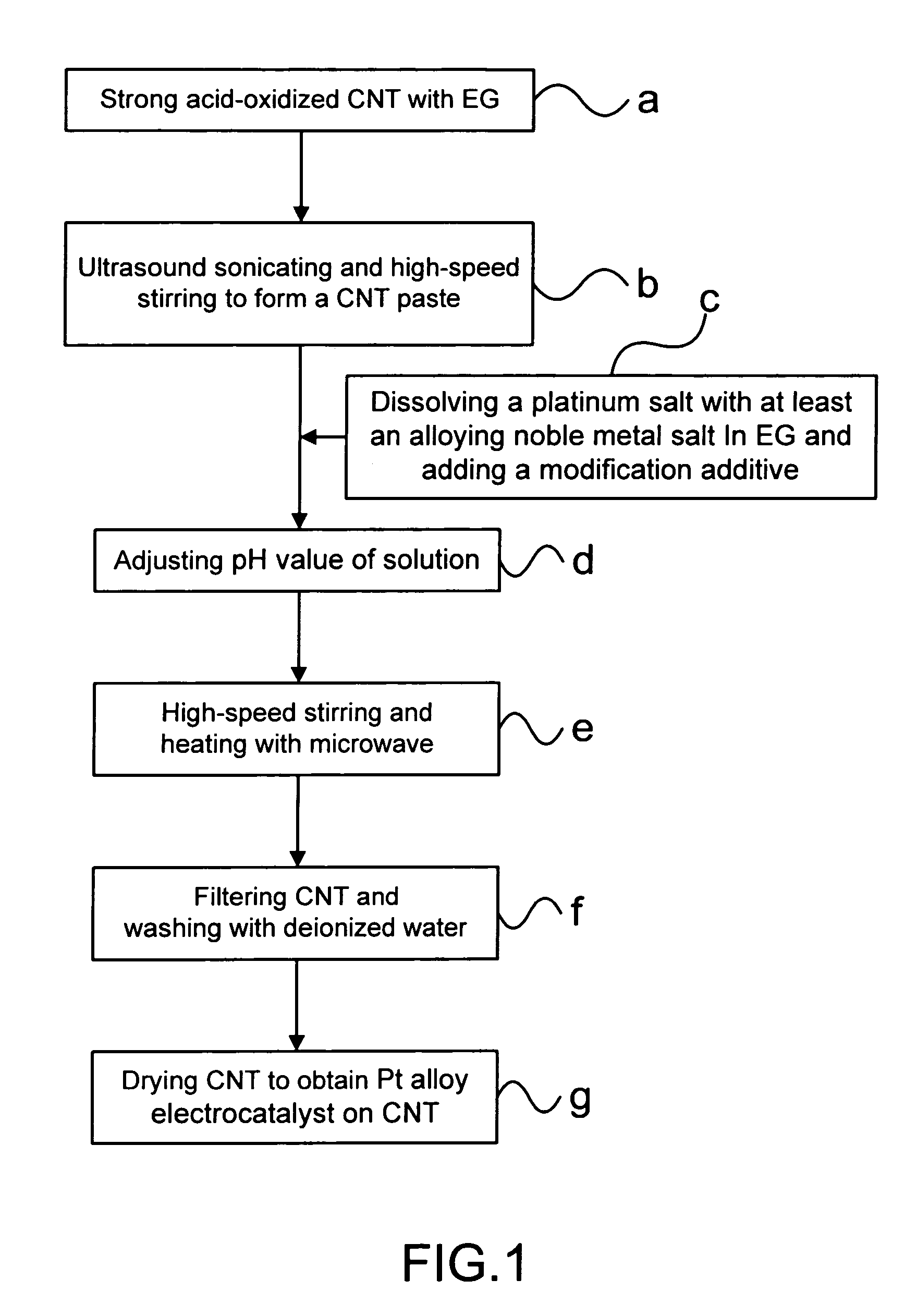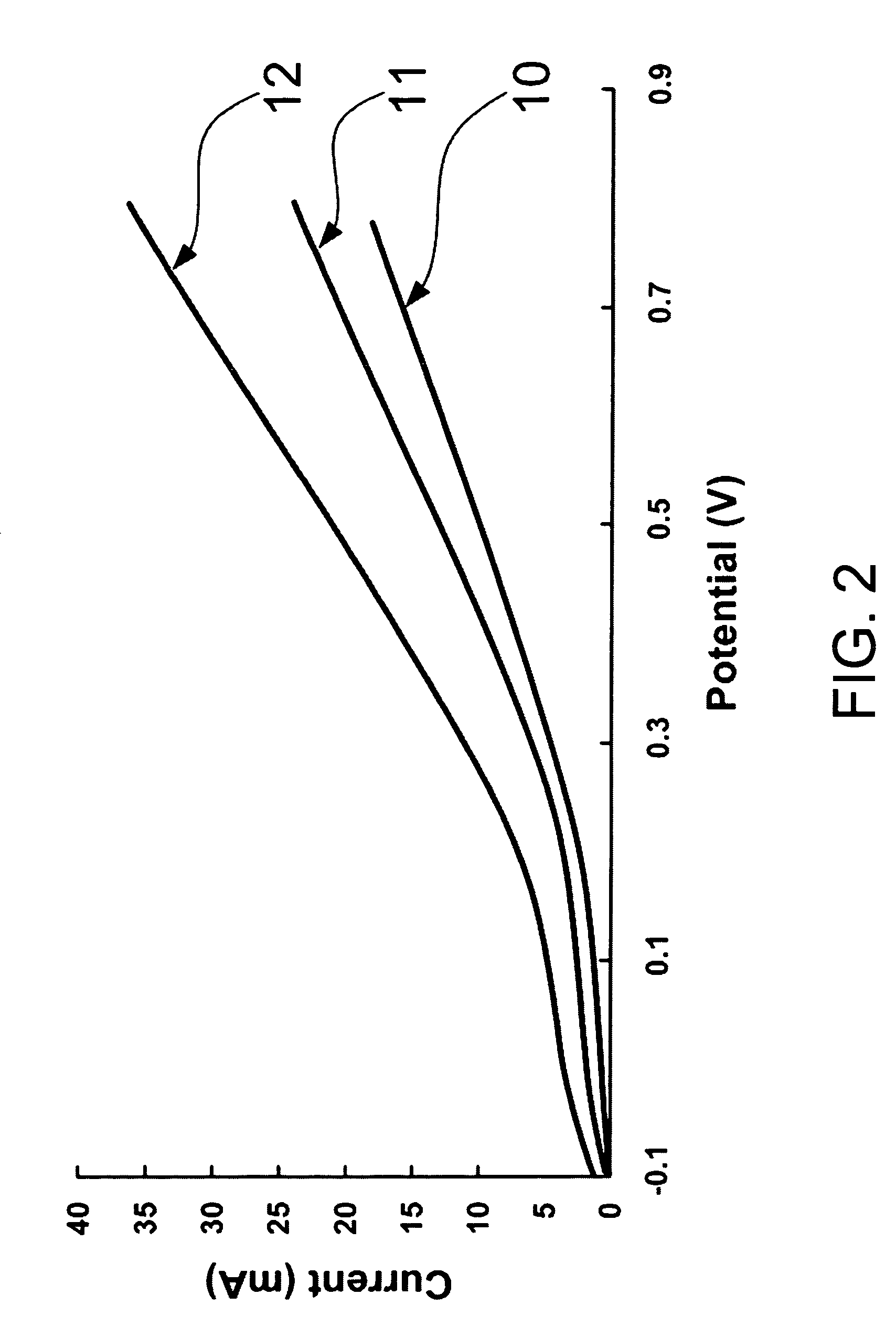Method for making carbon nanotube-supported platinum alloy electrocatalysts
a technology of electrocatalyst and carbon nanotube, which is applied in the direction of fuel cells, sustainable manufacturing/processing, climate sustainability, etc., can solve the problems of inability to successfully prepare cnt-supported pt alloy electrocatalysts using the same procedure, inability to reduce platinum ions and its alloying metal ions at the same time at the same ph value or at a competitive specific reduction rate using eg alone, and inability to redu
- Summary
- Abstract
- Description
- Claims
- Application Information
AI Technical Summary
Benefits of technology
Problems solved by technology
Method used
Image
Examples
example 1
[0022] Preparing a binary component Pt alloy electrocatalyst supported on a CNT (Pt-Ru / CNT)
[0023] Example 1 is to prepare a 20 wt % Pt-10 wt % Ru / CNT having an atomic ratio of ca. Pt:Ru=1:1 comprising the following steps:
[0024] Step (a): Pouring a 1.65 g (gram) of powder of a strong acid-oxidized CNT into a 50 ml (milliliter) of a first ethylene glycol solution.
[0025] Step (b): Obtaining a CNT paste having ethylene glycol from the first ethylene glycol solution through an ultrasound sonicating for 10 min and a high-speed stirring for 30 min.
[0026] Step (c): Dissolving a 1.264 g of H2PtCl6.6H2O and a 0.506 g of RuCl3 into a 10 ml of a second ethylene glycol solution; then, adding a 1 ml of 1 M (mole) NaHSO3 solution into the second ethylene glycol solution; and, then, adding the second ethylene glycol solution to the CNT paste.
[0027] Step (d): Adjusting a pH value of the mixed ethylene glycol solution to 2 with a 2N (moles) Ca(OH)2 solution.
[0028] Step (e): Processing a 30 min ...
example 2
[0033] Preparing a multi-component Pt alloy electrocatalyst supported on a CNT (Pt-Ru-Ir / CNT)
[0034] Example 2 is to prepare a 20 wt % Pt-10 wt % Ru-5 wt % Ir / CNT having an atomic ratio of ca. Pt:Ru:Ir=1:1:0.25, comprising the following steps:
[0035] Step (a): Pouring a 0.8 g of powder of an acid-oxidized CNT into a 50 ml of a first ethylene glycol solution.
[0036] Step (b): Obtaining a CNT paste having ethylene glycol from the first ethylene glycol solution through an ultrasound sonicating for 10min and a high-speed stirring for 30 min.
[0037] Step (c): Dissolving a 0.60 g of H2PtCl6.6H2O, a 0.25 g of RuCl3 and a 0.10 g of IrCl3.3H2O into a 10 ml of a second ethylene glycol solution; then, adding a 1 ml of 10% NaHSO3 solution into the second ethylene glycol solution; and, then, adding the second ethylene glycol solution to the CNT paste.
[0038] Step (d): Adjusting a pH value of the mixed ethylene glycol solution to 4 with a 1.5 ml of 4N Ca(OH)2 solution.
[0039] Step (e): Processing...
example 3
[0044] Testing the prepared Pt alloy electrocatalysts in a methanol oxidization using an electrochemical linear-sweep method
[0045] In Example 3, the obtained Pt-Ru / CNT or Pt-Ru-Ir / CNT is respectively fixed on the surface of a glassy carbon anode, having an surface area of 0.196 cm2, using a 5 wt % of Nafion solution, where the support capacity of the surface of glassy carbon anode is 2.5 mg / cm2 (miligram per square centimeter). The oxidization proceeds in a 0.5M H2SO4 aqueous solution containing 1M methanol using a linear sweep speed of 10 mV / sec (millivolt per second).
[0046] Please refer to FIG. 2, which is a view showing curves of current to potential in a methanol oxidation applied with a Pt-Ru / CNT and a Pt-Ru-Ir / CNT according to the preferred embodiment of the present invention and applied with a Pt-Ru / C of a prior art. As shown in the figure, a comparison is made concerning a methanol oxidization respectively done with the obtained Pt-Ru / CNT and the obtained Pt-Ru-Ir / CNT acco...
PUM
| Property | Measurement | Unit |
|---|---|---|
| temperature | aaaaa | aaaaa |
| temperature | aaaaa | aaaaa |
| temperature | aaaaa | aaaaa |
Abstract
Description
Claims
Application Information
 Login to View More
Login to View More - R&D
- Intellectual Property
- Life Sciences
- Materials
- Tech Scout
- Unparalleled Data Quality
- Higher Quality Content
- 60% Fewer Hallucinations
Browse by: Latest US Patents, China's latest patents, Technical Efficacy Thesaurus, Application Domain, Technology Topic, Popular Technical Reports.
© 2025 PatSnap. All rights reserved.Legal|Privacy policy|Modern Slavery Act Transparency Statement|Sitemap|About US| Contact US: help@patsnap.com



